|









|
Camouflage & Markings
|
|
|
|
|
Color
|
FS.
|
Paint
|
Remarks
|
|
RLM 68
|
FS34258/RAL 6013
|
Hu 80(50%)+Hu 151(20%)+Hu 34(30%)
|
Avia Green
|
|
Dark Green
|
FS34079
|
Hu 30
|
Spitfire,Piper,Dakota,Stearman etc
|
|
Dark Earth
|
FS30118
|
Hu 29
|
Spitfire,Piper,Dakota,Stearman etc
|
|
Ocean Grey
|
FS 35237
|
|
Spitfire (1948-1950)
|
|
Medium Sea Grey
|
FS 36293
|
|
Spitfire (1948-1950)
|
|
IAF Brown
|
FS 31433/ RAL8000 |
Hu 26(50%)+Hu29(25%)+Hu 34(25%)
|
Mustang,Harvard,Stearman etc
(1955-1968)
|
|
IAF Blue
|
FS 35053/RAL5008
|
Hu 25(80%)+Hu 33(15%)+Hu 96(5%)
|
Mustang,Harvard,Stearman etc
(1955-1968)
|
|
IAF Grey
|
FS 37722/RAL7044
|
Hu 64(70%)+Hu 34(30%)
|
Mustang,Harvard,Stearman etc
(1955-1968)
|
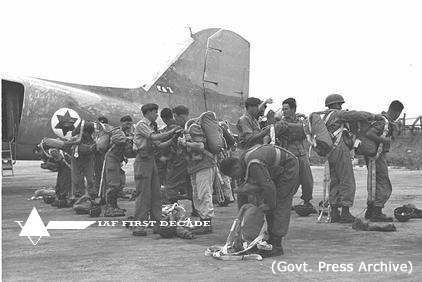
Paratroopers preparing for a training jump, in the background a Dakota of 103 Sq. Tel-Nof Oct 1949.
|
War of Independence
Controversy has persisted down through the years regarding
Israeli Air Force camouflage colors in 1948/49. The simple answer is that Israel was
under great pressure to get newly acquired aircraft into service and standardising
paint schemes was a low priority. Aircraft were used in whatever scheme they arrived
in, or were painted in any paint available to achieve a brown & dull green upper surface
with light blue under surfaces. Interviewed retired IAF technicians laughed at my suggestion
that any kind of standardised color scheme existed during 1948/49 period. According to
them ground crews simply sprayed or hand brushed old RAF paint, paint purchased from
Czechoslovakia, or locally manufactured paint that was used for general purposes.
To add to the confusion, machines in service were rarely repainted to comply with revised
tactical markings and colors with newly arrived aircraft at the squadron level.
|
|
ID stripesAnother area of debate are the colors of the identification stripes that were
applied by the IAF during 1948/49. By some sources it was claimed that the colors were
white/red/white, this is very unlikely and there is no evidence to support this option.
Another claim suggested white/black/white colors, this one is definitely not an option
for the simple reason that the REAF used those colors for it's own ID stripes. The last
left option and the most logical one white/blue/white ,those were the colors of the national
flag, and there are aye witness statements to support this claim.
|
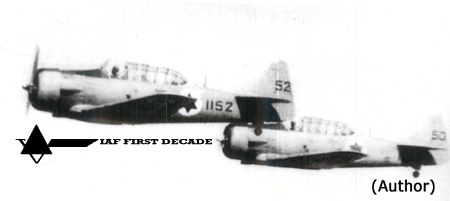
Two Harvard's from the flying school in a tight formation flight winter 1952.
|
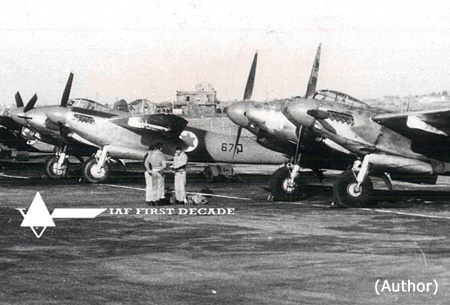
A line of Mosquito's Mk6 and Mk33 at Hatzor Jan 1955.
|
The 50's After the war of independence the major group that saw
substantial change in camouflage application were the training aircraft. The first
known and recorded system of marking training planes was intrudest in April 1949 by applying
120cm yellow stripes on the back portion of the cockpit, upper and lower wings and big white
two digits radio call number on the tail,e.g Harvard 1105/05 and Stearman 2702/02.After the opening
of the fling school in January 1950 two new types of camouflage colors were used by the IAF for
trainer aircraft (1)an overall trainer yellow with a black anti glare panel,e.g Harvard,Consul,stearman
and Mosquito Mk.III (2)a silver overall with red stripes on the fuselage and wings,e.g Stearman,Anson
and Consul.Other types of aircraft saw little change regarding their camouflage except the Dakota's
of 103 Squadron who got a natural metal finish until the mid fifties.In 1955 a major change in
camouflage colors was introduced the Blue and Brown on light Grey colors were applied almost on
every category of planes in service. This type of camouflage stayed in use until 1968.
|

Piper Cub A-63 of the Negav Sq. Oct 1948.
|
Numbering Systems
On 31 May 1948 the IAF issued orders regarding it's first standardised national
insignia and numbering systems. A Hebrew letter was assigned to each class of aircraft.
Light aircraft were given"Alef"(A),e.g. Piper Cubs and Austers;light bombers and small transports
"Bet"(B),e.g. Norseman and Bonanza;heavy bombers were assigned "Hay"(H),e.g. B-17;heavy transports
"Samech"(S),e.g. DC-3 and DC-46;fighters were assigned "Daled"(D),e.g. S-199,Mosquito and Spitfire.
Within the categories a range of numbers was assigned to an aircraft type,e.g. Avia D-101 to D-129,
Spitfire D-130 to D-159,Mosquito D-160 to D-169 and Beaufighter D-170 to D-179.These serial
numbers were to be painted on the rear fuselage forward of the tailplane in 20cm high digits
with 2cm stroke widths.Also included in the 31 May orders were basic instructions as to the size
and placement of national insignia. This comprised the 'Shield of David' on a white disk and was
to be painted in six positions. As all aircraft in service with the IAF at that time were
light aircraft,measurements for the white disk were specified at 85cm diameter above and below
wings and 45cm for fuselage insignia. These instructions were superseded in the field as in the
e.g. of the Avia's and Spitfires.In mid November 1948 an improved system encompassing
serial numbers for individual aircraft and radio calling code numbers was introduced. Each
serial number was to consist of four digits with the first pair representing the aircraft type
and the second pair the individual machine. It was to be painted on the fuselage. For fighter
types 19XX was assigned to S-199,20XX to Spitfires,21XX to Mosquitos and 23XX to Mustangs.
Thus an aircraft serialed 2042 would be Spitfire number 42.This system stayed in service until
the late 50's.
|
|
Serial number stylesWhen Spitfires D-130 & D-131 were taken on charge their 20cm
number was applied using the same stencils as had been used to number the S-199s by the CMU
unit. The November 1948 system"16XX"(B-17) saw seven different styles of size and placements.
The serials were applied at the field by the squadron, so Piper Cub from the "Galil" sq. had
a deferent style of numbers from that of a Piper Cub from the "Negav" Sq. and so on.
|
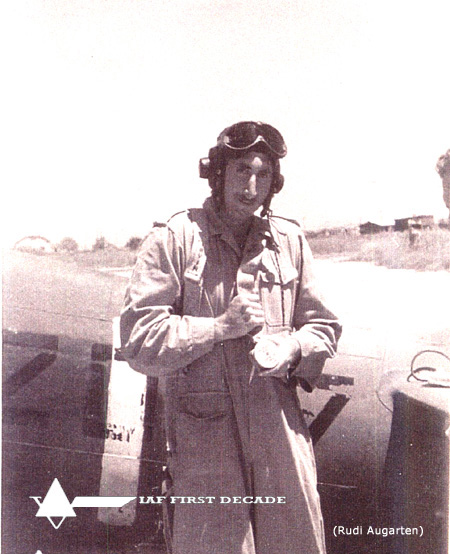
Rudi Augarten before a flight on Spitfire no 15/2027 Ramat-David Aug 1950.
|
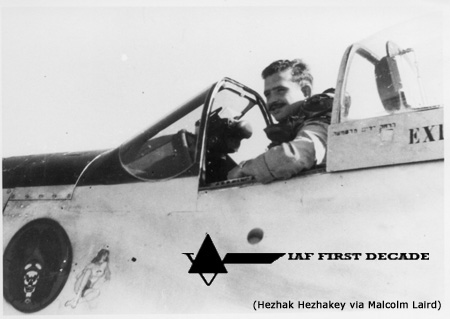
Mustang of 101 Sq. with a pin up art,pilot Jo Alon Ramat-David winter 1952.
|
Radio code numberCall sign numbers were first applied in November 1948 before
Operation Chorev, as 75cm high thick stroked white numbers. Generally an aircraft individual
serial number would also become it's radio call sign,e.g Harvard 1102/02,Mustang 2303/03.
However in same cases this tended not to be so for two reasons.Firstly:mixed formation Sq.adron's
like 101(S-199,Spitfire and Mustang),with the early single digit numbers taken up by the surviving
S-199 1905/05, hence Spitfire 2004/14 and Mustang 2301/40.Secondly: newly delivered Spitfires tended
to enter service out of serial sequence, while sq.adron commanders gave their aircraft radio call
signs based purely on the order in which they entered service(Spitfire 2016/23).By 1955 only the
radio call sign was applied on the fuselage,tail and wings.
|
Copyright © 2003 wings48.com, All Rights Reserved
Copyright Notice:
All material on this web site is the original work of wings48.com and is subject to copyright.
Permission is given to copy this material to your computer for individual use.
All other rights as to reproduction and dissemintion of these materials are reserved.
This material may not be reproduced in any form without the written permission of author.
|
|
|

